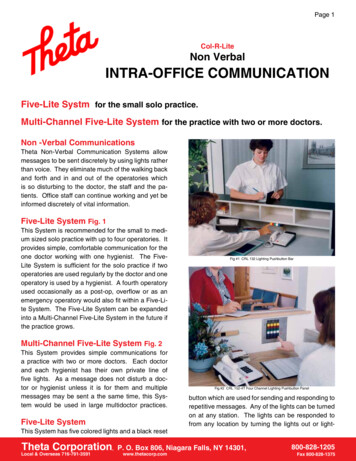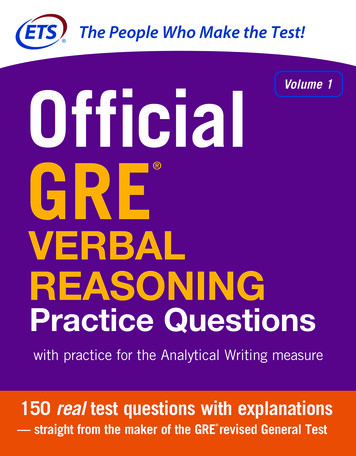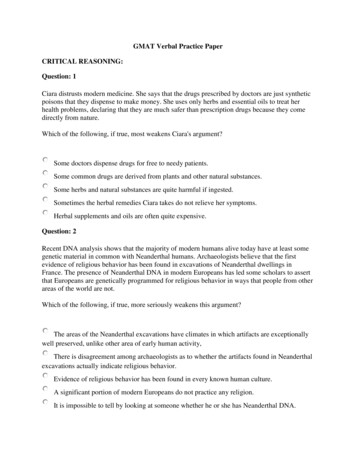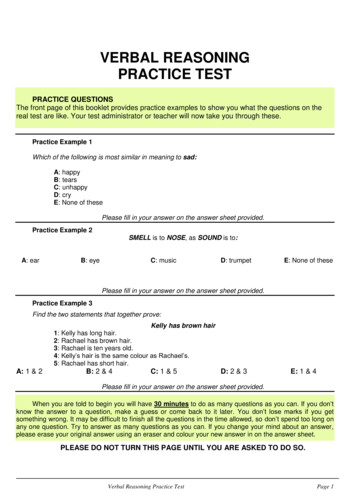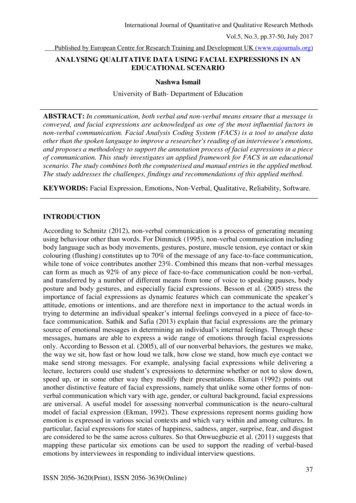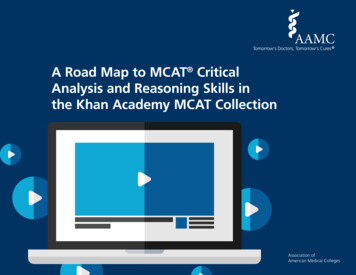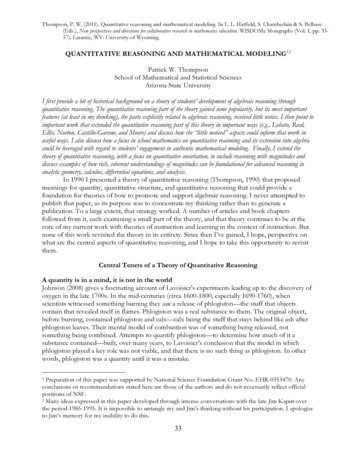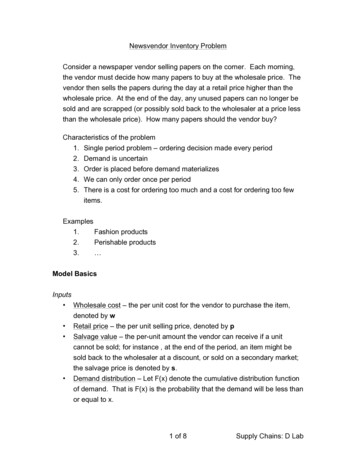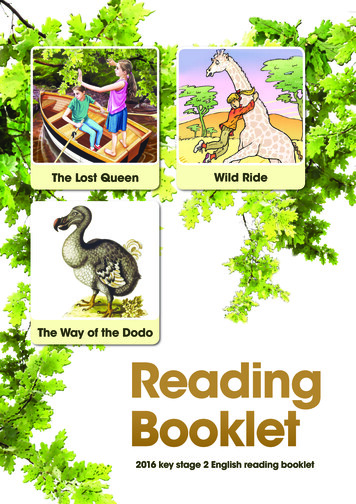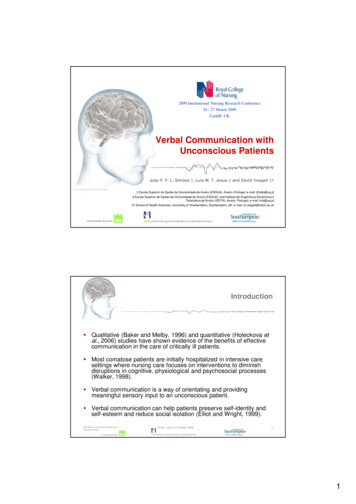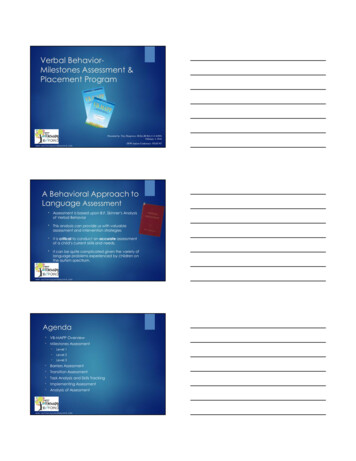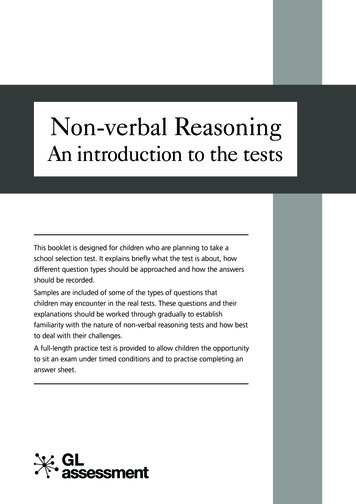
Transcription
Non-verbal ReasoningAn introduction to the testsThis booklet is designed for children who are planning to take aschool selection test. It explains briefly what the test is about, howdifferent question types should be approached and how the answersshould be recorded.Samples are included of some of the types of questions thatchildren may encounter in the real tests. These questions and theirexplanations should be worked through gradually to establishfamiliarity with the nature of non-verbal reasoning tests and how bestto deal with their challenges.A full-length practice test is provided to allow children the opportunityto sit an exam under timed conditions and to practise completing ananswer sheet.
For parentsAbout non-verbal reasoning selection testsThe test is designed to assess whether grammar school is a suitable option for yourchild. The tests have been designed and written by experts to test those skills provento indicate potential for academic success. They are timed tests that are sat in aformal examination environment on a set date and consist of a series of multiplechoice questions. Children read the questions in a test booklet and complete theiranswers on a separate answer sheet.How to use these materialsThe aim of this booklet is to familiarise children with the idea of a non-verbalreasoning test and with the materials they will use on the day of the test. Childrenthat are comfortable with the idea of taking a timed examination and with theformat will be more able to focus their energies on the questions themselves.The first part of this booklet looks at the general format of the test includinginstructions on how to mark answers. The next section provides some workedexamples of non-verbal reasoning questions and it is important that your child hasa good understanding of why the questions are answered in the way they arebefore moving on. The last part is a full-length practice test that should be taken inone sitting and timed appropriately. Answers and explanations are supplied at theend of the booklet.For pupilsWhenever you take a test it is important that you understand exactly what youhave to do. Successful preparation for your examination doesn’t just mean learningabout the types of questions in the test. You also need to know the rules of theexamination, how to behave, how to prepare yourself and how to correctly completethe tests so that the answers you submit are the ones you intended. You should alsoknow what it feels like to have to do the test in a certain time and be comfortablewith the idea of a test done by yourself.The materials in this pack have been designed to help you to prepare for such tests.They will help you to become familiar with the kind of questions you will face, andthe way you answer the questions. If you work through this booklet and try the fulllength practice test, you should be thoroughly prepared for the real selection tests.We will start by looking at some of the rules of the test and then at the way youanswer the questions. The later parts of this booklet look in more detail at the typesof questions you might face.Page 2
Test instructionsSome instructions will be spoken to you; others will be written in the testbooklet. Try to remember the following: Read the instructions on the front of the test booklet Listen carefully to invigilators – they are the adults who will guide you through theprocess of sitting the test. They will give you instructions about what to do There are some points in the test at which you will be asked to stop workingand not turn the page. In non-verbal reasoning tests, you will be giveninstructions and examples before each new section. Each section is timedseparately. At the bottom of each page in the test booklet are instructions telling you to:Stop Do not turn over until you are told to do so! go onPlease go on to the next page or that you have reached the end of the test.END OF NON-VERBAL REASONING TESTTest materialsIt is vital that you know how to submit your answers for marking. This booklet givesyou the opportunity to practise this.On the day, you will have two things provided: a test booklet, containing thequestions, and a separate answer sheet.You will need to bring with you a pencil, a spare pencil and an eraser.Page 3
The answer sheetOnly the answers you fill in on the answer sheet will be marked. The sheetis read by a special scanning machine so you need to mark it in a particular wayin order for your responses to be clear. You can get an adult to check that you aredoing it correctly.The top of the answer sheet will show the name of the test and some informationabout you, including your name and date of birth. Check that your name and date of birth are correct. Tell an invigilator ifyou think there is a mistake If the boxes are blank, you will need to fill them out. Ask an invigilator to help.The rest of the answer sheet contains spaces for you to submit your answers. Eachquestion has its own box containing the answer options. The question number is inthe top left hand corner. For example, question 1 might look like this:1ABCDEPage 4
You answer each question by putting a thin horizontal line in the rectangle next toyour answer, like this (you can practise this later on in this booklet): If you make a mistake, rub it out as completely as you can and put in your newanswer. You must only use a pencil to mark the answer sheet. All the questions you do will be multiple choice.That means that you are given a range of answers to choose from. The answeroptions will be printed in the test booklet but you must submit your responses onthe answer sheet. You may need to fill in answers on both sides of the answer sheet. You must make sure that you mark your answers in the right place on theanswer sheet. Mark your answer in the box that has the same number as thetest question. You must make sure that all your answers are recorded on the answer sheetbefore the end of the test.The test booklet:The test contains a number of different non-verbal reasoning question types. Youneed to try to answer all of the questions.The test is divided into individual sections which are timed separately. Instructionsare given before the start of each section along with an example question. You willalso be asked to do some practice questions. These are not marked but help youunderstand the type of questions you are about to answer.You can do rough work in the booklet if you need to, or on a separate piece ofpaper. But remember: the test booklet won’t be marked. All your answers must goon the answer sheet.Page 5
Non-verbal Reasoning TestsWhat will I be tested on?The questions are tests of ability, not what you have learned elsewhere in school.They require skills that are needed to succeed in secondary education, including yourability to: understand and analyse tasks work quickly and carefully apply attention to detail solve problems using unfamiliar shapes and images acquire new ideas and concepts repeat a particular task at increasing levels of difficultyHow long does the test last?Non-verbal reasoning tests have individually timed sections. There are four sections inthe North Yorkshire Non-verbal reasoning tests. Each lasts 10 minutes.Instructions, as well as the example and practice questions are not part of thetiming.Remember, there will be times when you need to sit and listen to instructions, tomake sure that your answer sheet has been handed in or to wait for other pupils inthe room to finishWhat kind of questions will be asked?The non-verbal reasoning test asks you questions involving the manipulation ofshapes and images. There are different types of questions based on identifyingrelationships between things and then identifying a new example of thatrelationship. They are designed to test your ability to recognise detail and differences,separate the relevant from the irrelevant and to manipulate this information inyour head.In the next section, you will begin to familiarise yourself with some types ofnon-verbal reasoning questions, start to understand what they ask you to do andhave a go yourself.In the last section of this booklet, you will be able to sit a full-length practice test.Page 6
Non-verbal Reasoning QuestionsTo do this section you will need: This booklet. The familiarisation test answer sheet (found towards the end of this booklet) Two sharpened pencils. An eraser to change answers if necessary.The answers to the questions can be found on page 42.There are many different types of non-verbal reasoning questions. To help you tounderstand the different types we have put them into three groups. The next sectionlooks at example and practice questions from each group. Finding similarities and differences. Completing diagrams. Cracking codes.The questions shown here and in the practice test are not necessarily thesame as the questions you will face in the real test. They have been chosento let you practise the skills that you need.General guidance: Read the instructions for each item type carefully. In the real test each questiontype has the same instructions as are used here. Make sure you are clear about what you are being asked to do before attemptingthe practice questions. Practice putting your answers on the separate answer sheet.Page 7
Finding similarities and differences: find the diagram like the first threeOn the left of each of the rows below there are three figures that are alike. On the rightthere are five more figures: find which of these is most like the three figures on the leftand mark its letter on your answer sheet.ExampleaAnswerbccddecIn this example, all the diagrams on the left are triangles – they all have three sides.Therefore, c is the correct answer as it is the only one of the five diagrams that isa triangle.Now try these two practice questions and mark your answers on the answer sheet.P1P2abbccddeabcdeOther similar types of question to this include: Find the diagram like the first twoThese questions are like the ones you have just attempted but instead of threefigures on the left of the line, there are two. Find the odd one outIn these questions, you are shown a row of five figures. You have to find thefigure that is most unlike the other four shapes.You will have the chance to try these types of questions in the practice test at theend of the bookletPage 8
Completing diagrams: complete the gridIn the big square on the left of each line below one of the small squares has been leftempty. One of the five figures on the right should fill the empty square. Find this figureand mark its letter on your answer sheet.ExampleaAnswerbcdedIn the example above the two shapes at the top are both the same, except that thecircle on the left is white and the one on the right is black. In the bottom left, thereis a white shield shape. To complete the pattern, the missing shape has to be a shieldthat is shaded black, so the correct answer must be d.Now try these two practice questions and mark your answers on the answer sheet.P3abPage 9cde
P4abcdeOther similar types of question to this include: Complete the seriesIn these questions, five squares are arranged in order, each containing a shape orfigure. One of the squares is left empty. You have to find the right square to takethe place of the empty square. Complete the pairIn these questions, you are shown two shapes with an arrow between them. Thearrow signifies a change or other relationship between the shapes. You have todecide what this relationship is how the second shape is related to the first. Youare then shown a third shape. You have to decide which of five shapes goes withthis third shape to make a pair like the first two shapes. These questions are alsoknown as analogies.You will have the chance to try these types of questions in the practice test at theend of the booklet.Cracking codes: crack the horizontal codeTo answer these questions you have to work out a code. In the boxes on the left areshapes and the code letters that go with them. The top letters mean something differentto the bottom ones. You must decide how the letters go with the shapes. Then find thecorrect code for the test shape from the set of five codes on the right. Mark its letter onyour answer sheet.Page 10
ExampleTEST SHAPEaAnswerbcdebIn the example above, two of the top letters are the same (Y) and one is different (X).Two of the three bottom three letters are also the same (S) and one is different (T).The top letters will therefore describe a feature that is shared between the secondand third diagrams but is different from the first – in this example this is the shape,as the first shape is a circle and the second and third are squares.The bottom letters must describe a feature that is common to the first and thirddiagrams, but different from the second. In this case the letters must related to theshading, as the first and third shapes are not shaded whereas the middle shape isshaded with diagonal lines. The test shape is a shaded circle. The code for circle is ‘X’and for a shaded shape is ‘T’. The answer is therefore b.P5Now try these two practice questions and mark your answers on the answer sheet.P6abcdeabcdeOther similar types of question to this include: Crack the vertical codeLike the questions above, these questions ask you to work out a code relatingshapes to letters.You will have the chance to try these types of questions in the practice test at theend of the booklet.Page 11
Practice TestThe following test is designed to help you prepare for a full-length test sat undertimed conditions.Information for pupils: Before sitting the test, make sure you have a quiet place to work and a clock tomonitor the time. The test lasts for 40 minutes but each section is individually timed. The wholeprocess will take around 50 minutes. Some of the items are the same as those you worked through in this booklet.Others will be different. Make sure you read the instructions for each questioncarefully. There may be other types of question in the real test. Some will also be the sameas are in this practice test. Not all the questions are as difficult as those included in the real selection tests.Therefore the score obtained on this test will not necessarily reflect your score onthe actual selection tests. Each section starts with an example question showing the correct answer.Information for parents: Non-verbal tests are divided into sections, each timed separately. Each section lastsfor ten minutes but do not start timing until your child has read all the instructionsand/or filled in all the details at the top of their Answer Sheet. The answers can be found on page 44.Different ways to sit the test:The test has four separate sections. Each section is preceded by instructions on howto answer the questions, one or two examples and some practice questions (you willfind that some are the same as the practice questions above). This is then followedby 20 test questions.In the actual exam, the invigilator will read these instructions aloud to candidates.There are three main ways you can do this Non-Verbal Reasoning test at home:1. a. Turn to Section 1 of the test booklet with your child. Read through theinstructions at the top together. Then ask your child to do the practicequestions, giving them the answers to these when they have finished (seeAnswer Key below). Finally, time them for ten minutes on the following20 questions.Page 12
b. After ten minutes have elapsed, stop your child, unless they have not finished.If this is the case, draw a line underneath the question they are on, or draw aring round its number, and then let them carry on until they have completedthe section. When you mark the test you will be able to see how manyquestions your child got right in the allocated time and how many questionsoverall. This will give you a good indication of whether they need to developtheir speed and/or work more accurately.Further guidance on developing your child’s speed and accuracy is provided inGL Assessment’s Official Parents’ Guide to the 11 , available from high streetretailers and online.c. Repeat this procedure for the other four sections.OR2. a. Ask your child to read through the example in the first section by themselvesand do the practice questions, then give them the answers (see Answer Keybelow). They should tell you when they are ready to begin the timed section.You should then time them for ten minutes on the following 20 questions.b.As above for option 1.c.As above for option 1.OR3. a. You can simply give the test to your child and ask them to read through andcomplete it on their own, with no help, involvement or timing on your part.In this case you will not be able to give them the answers to the practicequestions until they have finished the whole test. You should tell them toignore the instructions stating ‘Wait until you are told to go on’.Please note, if you want your child to experience the test as closely as possible to thereal test, then you should choose Option 1.Page 13
Page 14
Section 1On the left of the example below are two shapes with an arrow between them. Decide howthe second is related to the first. After these there is a third shape, then an arrow and then fivemore shapes. Decide which of the five shapes goes with the third one to make a pair like thetwo on the left. The correct answer has been marked on your answer sheet.ExampleaabbccddeeAnswer: bNow do the two practice questions below. Mark the correct answers on your answersheet.P1abcdeabcdeP2Page 15Do not turn over until you are told to do so!
1abcdeabcdeabcdeabcdeabcde2345Page 16
6abcdeabcdeabcdeabcdeabcde78910Page 17
11abcdeabcdeabcdeabcdeabcde12131415Page 18Please go on to the next page
16abcdeabcdeabcdeabcdeabcde17181920Page 19Do not turn over until you are told to do so!
Page 20Please go on to the next page
Section 2To answer these questions you have to work out a code. On the left are some shapes and thecodes that go with them. You must decide how the code letters go with the shapes. Then findthe correct code for the test shape from the set of five codes on the right and mark its letteron your answer sheet.ExampleTest shapeabcdeAnswer: aDecide what the code letters mean. The first letter is the same for both shaded shapes, so Smust be the code for shading and T the code for white. The second letter is different for eachshape, so X, Y and Z must be the codes for arrow, square and diamond. Therefore the testshape must have an S code for shading and a Z code for diamond. So the answer is SZ and ahas been marked on the answer sheet. Now do the two practice questions below and markyour answers on the answer sheet. Remember there is a new code for each question.P1abcdeabcdeP2Page 21Do not turn over until you are told to do so!
21abcdeabcdeabcdeabcdeabcde22232425Page 22Please go on to the next page
26abcdeabcdeabcdeabcdeabcde27282930Page 23Please go on to the next page
31abcdeabcdeabcdeabcdeabcde32333435Page 24Please go on to the next page
36abcdeabcdeabcdeabcdeabcde37383940Page 25Do not turn over until you are told to do so!
Page 26Please go on to the next page
Section 3On the left of the example below there are two figures that are alike. On the right there arefive more figures: one of these is most like the two figures on the left and its letter has beenmarked on your answer sheet.ExampleaabbccddeeAnswer: cNow do the two practice questions below. Mark the correct answers on your answersheet.P1abcdeabcdeP2Page 27Do not turn over until you are told to do so!
41abcdeabcdeabcdeabcdeabcde42434445Page 28Please go on to the next page
46abcdeabcdeabcdeabcdeabcde47484950Page 29Please go on to the next page
51abcdeabcdeabcdeabcdeabcde52535455Page 30Please go on to the next page
56abcdeabcdeabcdeabcdeabcde57585960Page 31Do not turn over until you are told to do so!
Page 32Please go on to the next page
Section 4To the left in the example below there are five squares arranged in order. One of thesesquares has been left empty. One of the five squares on the right should take the place of theempty square and its letter has been marked on your answer sheet.ExampleabcdeAnswer: bNow do the two practice questions below. Mark the correct answers on your answersheet.P1abcdeabcddeeP2Page 33Do not turn over until you are told to do so!
61abcdeabcdeabcdeabcdeabcde62636465Page 34Please go on to the next page
66abcdeabcdeabcdeabcdeabcde67686970Page 35Please go on to the next page
71abcdeabcdeabcdeabcdeabcde72737475Page 36Please go on to the next page
76abcdeabcdeabcdeabcdeabcde77787980Page 37END OF NON-VERBAL REASONING TEST
NON-VERBAL REASONING FAMILIARISATION TESTPractice questionsPupil’s NameDate of TestSchool NameDaySCHOOL NUMBERSCHOOL ase mark boxeswith a thin horizontalline like this — ][7][8][9][[0]1][2][3][4][5][6][7][8][9][[DATE OF 200020012002200320042005200620072008Finding similarities and differences: find the diagram like the first threeEXAMPLEPRACTICE 1ABCDEPRACTICE 2ABCDEABCDECompleting diagrams: complete the gridEXAMPLEPRACTICE 3ABCDEPRACTICE 4ABCDEABCDECracking codes: crack the horizontal codeEXAMPLEPRACTICE 5ABCDEPRACTICE 6ABCDEABCDEPage 38 GL Assessment 2015. All rights reserved. Not to be reproduced in any form or by any means, even within the terms of a Photocopying Licence without thewriiten permission of the publishers. Published by GL Assessment, 9th Floor, 389 Chiswick High Road, London W4 4AJ. 1(08.15) PF
Page 39
NON-VERBAL REASONING FAMILIARISATION TESTAnswer Sheet Questions 1 – 40Pupil’s NameDate of TestSchool NameDATE OF BIRTHDaySCHOOL NUMBERSCHOOL ase mark boxeswith a thin horizontalline like this — OctoberNovemberDecemberSection CDEABCDESection ABCDE40ABCDEABCDEPage 40 GL Assessment 2015. All rights reserved. Not to be reproduced in any form or by any means, even within the terms of a Photocopying Licence without thewriiten permission of the publishers. Published by GL Assessment, 9th Floor, 389 Chiswick High Road, London W4 4AJ. 1(08.15) PF
NON-VERBAL REASONING FAMILIARISATION TESTAnswer Sheet Questions 41 – 80Section ABCDE60ABCDEABCDESection ABCDE80ABCDEABCDEPage 41 GL Assessment 2015. All rights reserved. Not to be reproduced in any form or by any means, even within the terms of a Photocopying Licence without thewriiten permission of the publishers. Published by GL Assessment, 9th Floor, 389 Chiswick High Road, London W4 4AJ. 1(08.15) PF
Familiarisation Questions Answer KeySectionFinding similaritiesand differencesQuestionAnsweroptionExplanationP1eAll three shapes on the left-hand side aredifferent but they all have a black spot in theirmiddle. Only one shape in the group on the righthas a black spot. Therefore, the answer is E.P2bThe first three figures are lines with one commonfeature: they all have one small, unfilled squareoverlapping somewhere along the line.The only figure with a similar square from theanswer options is figure B.CompletingdiagramsP3aThe arrow-like shape in the top-left square isalso in the top-right square. But in the top-rightsquare it has been rotated 90º clockwise: insteadof pointing upwards, it now points right.The empty square should therefore be filled bya shape that is the same as the shape in thebottom-left square but rotated 90º clockwise. Theanswer is therefore A.P4cThis diagram has nine squares with each squarefilled with one of two types of shape. The orderof the shapes is alternate (whichever way youfollow the pattern).The empty square should therefore be filled withthe arrow-like shape and must be pointing thesame way and be the same colour as all the otherarrow-like shapes. The answer, therefore, is C.Page 42
Cracking codesP5aWhich of the diagrams have something incommon? The first and third have circles. Theyalso both have the letter ‘M’. Therefore the topletter must stand for the shape. The test shape isa triangle so should have the letter ‘N’ (the sameas the second diagram).The three diagrams have three different bottomletters and also three different numbers of dotsin their shapes: none, one and two dots. The testshape has no dots and should share a letter withthe first diagram, the letter ‘G’.The answer to the question is therefore option A,the letters ‘N’ and ‘G’.P6eIn this question, the second and third diagramsshare a letter ’S’ at the top and also have thesame shape. The first and fourth diagramsalso share a top letter and a shape, a hexagon.Therefore, the top letter describes the shape. Thetest shape is a hexagon and should therefore alsohave an ‘R’.The first and third diagrams share a bottom letter.They have different shapes but they have thesame shading. The test shape has no shading.The only other diagram with no shading is thesecond, which has a bottom letter ‘G’.Therefore the answer is ‘R’ and ‘G’, answeroption E.Page 43
Practice Test Answer KeyThe answers for the practice test are below. Only these answers are allowed. Onemark should be given for each correct answer – do not allow half marks or ‘thebenefit of the doubt’. Do not deduct marks for wrong answers.Remember to take into account the answers your child completed once the time forthe test was up and the questions answered after that point.The results may suggest that more practice is needed. Remember, always try to bepositive and encouraging. Talk through the mistakes your child has made in anon-condemnatory way – work out together how to get the right answer.Section 1Section 2Section 3Section 60a80dPage 44
Some final reminders Read the instructions on the front of the test booklet. Read the instructions for each section carefully. Listen carefully to invigilators and the instructions they give you. They are there tohelp you. Check that your name and date of birth are correctly shown on the answer sheet. There are some points in the test at which you will be asked to stop working andnot turn the page. Be sure to keep your place on the answer sheet. Mark your answer in the box thathas the same number as the test question. Make sure all your answers are recorded on the answer sheet before the end ofthe test.Page 45
Page 46
Page 47
Copyright GL Assessment, 2015.All rights reserved, including translation. This publication has been licensed to NorthYorkshire County Council by GL Assessment allowing the Council to distribute thispublication free of charge to Pupils intending to undertake admissions tests, or theirParents. This publication may not be sold or distributed as part of any product orservice, including via private tuition. No part of this publication may be reproduced ortransmitted in any form or by any means, whether physical or electronic (other than byNorth Yorkshire County Council for the purpose indicated above) without permissionin writing from the publishers, and may not be photocopied or otherwise reproducedwithin the terms of any licence granted by the Copyright Licensing Agency Ltd.Published by GL Assessment, 9th Floor, 389 Chiswick High Road, London W4 4AJ.Printed in Great Britain.Code 6800 1111(07.15) PF
answer sheet. Mark your answer in the box that has the same number as the test question. You must make sure that all your answers are recorded on the answer sheet before the end of the test. The test booklet: The test contains a number of different non-verbal reasoning question types. You nee
